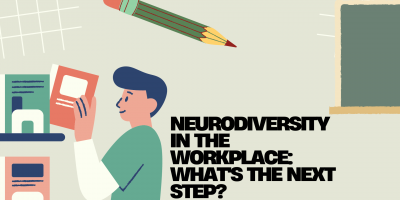
Neurodiversity in the Workplace: What’s the Next Step?
The conversation on neurodiversity in the workplace is expanding, but significant improvement has yet to be made. What’s the next strategic move for employers to drive progress?


Founder & CEO of The New Workforce

Editor Manager at Biz Report
Over the past three years, businesses and employees alike have been operating in a state of perpetual chaos and disruption.
The lingering effects of the pandemic, paired with political instability, rounds of layoffs, and a cost-of-living crisis, have all taken a toll on employees’ mental health and well-being.
The latest statistics show that nearly half of all Americans will experience a behavioral issue in their lifetime, from a substance use problem to a mood disorder.
As a result, almost 77% of employers are currently experiencing increased levels of mental health needs – necessitating a deeper approach to behavioral health.
While mental health programs have been recognized as a critical part of overall wellness for years, employers are now seeing a growing demand for expanding their services, filling in gaps of care, and increasing access to them.
In this report, we investigate the evolving state of mental health and explore preventative and proactive approaches employers are adopting to address both existing and emerging challenges in this area.

In the employer benefits space, several new benefits have gained importance and become the standard over the years. Mental health is one such example, as it’s now an integral part of every employer’s benefits strategy.
Our data shows that supporting employees at every step of their mental health journey has been a top concern for employers, particularly in the wake of the pandemic.
The 2021 Workplace Wellness Trends Report from Shortlister revealed a massive increase in the demand for behavioral health benefits.
Although the demand has leveled off from these high peaks in subsequent years, mental health programs continue to rank among the most sought-after services, consistently leading in terms of successfully closed deals.
Similarly, insights from leading experts within our network echo the same sentiment.
Kraig Kleeman, CEO and founder of The New Workforce, remarked on the increased attention to mental health, noting, “Mental health is finally getting the spotlight it deserves.”
He adds, “Companies are catching on that they must do more to keep their folks mentally fit. We’re talking about making therapy sessions easy, giving people days off to chill, and teaching managers how to spot when someone’s struggling.”
Young Pham, Editor Manager at Biz Report, also emphasized the ongoing importance of mental health in the workplace. He pointed out, “The aftermath of the COVID-19 pandemic has underscored its importance, and companies are expected to make it a central element of their wellness programs.”
To better understand the future of mental health benefits, it’s essential to examine the current trends shaping the industry.
Historically, employees avoided discussing feelings of depression and anxiety, especially in the workplace, because of the fear of how they’d be perceived, which led to many unreported and untreated cases.
Today, all of that is changing.
The stigma surrounding mental health is lessening, and treatments are becoming more mainstream and easily accessible.
Yet, despite this progress, when we look at the latest data, many worrying trends show employees’ mental health is still suffering.
One in three American workers report worries about their emotional well-being or mental health, while one in four describe their mental health as either fair or poor.
In fact, the consequences of this mental health crisis are already apparent, with depression rates reaching an all-time high, suicide rates on the rise, and nearly a quarter of Americans admitting they use illicit drugs.
For American employees facing mental health and substance use issues, having an employer that provides resources and assistance can be life-changing, as they are often the primary source of treatment coverage.

Employers clearly understand the importance of mental health support for their staff, with 61% confirming that they have noticed an increase in the need for mental well-being products.
Similarly, most workers (54%) also believe that offering mental health benefits has become even more important over the past year.
However, going beyond simply offering benefits, employees want companies to acknowledge that work itself is a major contributing factor to our mental and psychological state.
A worldwide survey by the Workforce Institute at UKG revealed that many people believe their job has the biggest influence on their mental health.
Interestingly, the study also showed that managers affect our mental well-being just as much as, if not more than, doctors and therapists and are equal to that of spouses or partners.
Given this, it’s not surprising that most employees (78%) feel employers are responsible for offering help and support in this area.
However, supporting emotional well-being isn’t just an ethical choice for employers; it’s also in their best interest for many reasons.
Today, it’s widely known that stress and other mental health conditions have harmful effects on people’s health. They are linked to serious conditions like cancer, high blood pressure, cardiovascular disease, and a multitude of other health complications.
In the workplace, stress can negatively impact productivity and lead to higher voluntary turnover rates. Moreover, mental health issues significantly contribute to the overall disease burden, leading to other health problems, disabilities, and even increased mortality rates.
In fact, such conditions are already driving up healthcare costs at double the rate of other health issues. In the United States, this results in almost $200 billion in healthcare costs annually for employers.
Investing in workplace benefits that promote health and well-being is beneficial for both employees and the organizations they belong to. For instance, businesses typically see a return of approximately $7 for every $1 spent on mental health initiatives.
Yet, the reality is that many employees simply don’t have access to benefits that would promote better psychological well-being.
APA’s 2023 Work in America Survey shows that:

While the growing recognition for better behavioral health is a step in the right direction, many workers are encountering another hurdle on the path to wellness.
Further complicating the situation is that the US is suffering a substantial healthcare workforce shortage, and with a rapidly aging population, experts fear it will only worsen over time.
As of April 2024, according to data from the Health Resources & Services Administration, there is a shortage of:
Over 169 million people in the US, which is more than half the population, live in areas known as Mental Health Professional Shortage Areas (Mental Health HPSAs).
These shortfalls are even more pronounced in predominately minority communities, thereby significantly worsening the burden of health inequalities in the country.
Therefore, it comes as no surprise that four of the top six reasons why people didn’t get mental health help were related in some way to network adequacy.
While affordability is the primary concern, other reasons include not knowing where to go for services, insufficient time, and health insurance not paying enough for mental services. What’s particularly concerning is that the national average wait time for behavioral services is 48 days, which can be even longer for certain specialties.
The good news is that as much as 30% of employers recognize that this shortage of healthcare providers is making it harder for employees to get care, and another 36% expect to encounter this issue in the future.
For these reasons, when asked about their top priorities for benefit programs over the next 3 to 5 years, the nation’s leading employers ranked improving access to mental health services as their number one priority.
In response to this ongoing shortage, employers are expanding offerings, introducing telehealth services, offering on-site mental help, and training managers to recognize mental health issues to support employees better.
Almost a quarter of employers have addressed the persistent lack of behavioral health specialists by partnering with an additional network of behavioral health providers – usually a virtual one.
Tele-behavioral health services remove accessibility barriers for employees in underserved areas and provide more privacy which addresses barriers associated with patient stigma.
Another approach that almost two-thirds of employers are taking is expanding their employee assistance program (EAP). Increasing the number of covered sessions, including online and self-help options, can simplify the process for employees receiving help.
Furthermore, companies are educating managers on becoming more empathetic and flexible leaders when supporting their workforce. As much as 74% of companies are stepping up efforts to train their managers to help recognize mental health issues and know how to direct employees to the right resources.
Aside from focusing on the benefits offerings, employers are also reexamining their policies and adding mental health leave days, flexible work arrangements, partnering with employee resource groups (ERGs), and reevaluating their mental health initiatives through a DEI lens.
As healthcare is continuously innovating and evolving, companies need to also be on the lookout for many emerging technologies that can help them solve the complex challenges of emotional wellness.

From technological advancements to innovative treatments, these new frontiers have the potential to change the way we understand and treat mental health.
Throughout the last year, leaders have explored ways to harness the power of AI – even in unconventional ways like offering behavioral health support in the workplace.
By examining employee communications like surveys and emails or through data collection from wearables, intelligent systems can spot when someone feels stressed, burnt out, or facing other mental health challenges. Thus, HR or wellness teams can step in early and offer the needed help.
In addition, AI chatbots are available 24/7 to offer instant support for anyone struggling, making it easier and less intimidating for employees to seek help when they need it.
One groundbreaking benefit that has emerged over the last year is psychedelic-assisted therapy (PAT). Numerous researchers believe that combining psychedelics with psychotherapy has the potential to revolutionize health care.
Primarily, it’s used in treating psychiatric health issues like treatment-resistant depression and other mood disorders like PTSD that haven’t improved after several traditional interventions.
In the US, some companies have begun to include Psychedelic-Assisted Therapy (PAT) as an employee benefit, potentially paving the way for this innovative treatment method to become mainstream.
In 2024, digital cognitive behavioral therapy (dCBT) emerged as one of the leading mental health services being adopted.
Cognitive behavioral therapy typically explores the link between thoughts, feelings, and actions. Essentially, it guides individuals to reflect on their perceptions of themselves, others, and their circumstances to grow positive thought patterns and behaviors.
The digital form of therapy is accessible online via various platforms such as patient portals, apps, and more.
Ultimately, given the rising demands and challenges in the modern workplace and the critical role employers play in providing mental health support, the significance of mental health investments will only continue to expand in the future.
Based on internal data from Shortlister, our users typically look for mental health benefits by using the following set of keywords:

Senior Content Writer at Shortlister
Browse our curated list of vendors to find the best solution for your needs.
Subscribe to our newsletter for the latest trends, expert tips, and workplace insights!

The conversation on neurodiversity in the workplace is expanding, but significant improvement has yet to be made. What’s the next strategic move for employers to drive progress?

Is a high-earning job worth it if you don’t have enough free time to enjoy its benefits?

Entering the workforce amidst a mental health crisis, Gen Z pushes for better employee well-being. What can employers do to address this issue effectively?

Prevent adverse outcomes by implementing the correct type of conflict management strategies in the workplace.
Used by most of the top employee benefits consultants in the US, Shortlister is where you can find, research and select HR and benefits vendors for your clients.
Shortlister helps you reach your ideal prospects. Claim your free account to control your message and receive employer, consultant and health plan leads.